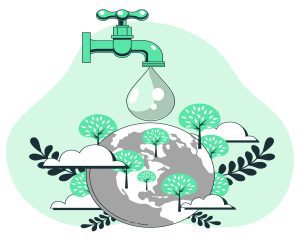- Introduction to the InternetIn this blog note of CSIT, we are here to study about Internet and its Services that are designed for IT scholars. So, let’s get started:
Definition: The Internet is a global network of interconnected computers that communicate through standardized protocols. It allows for the sharing of information and resources across vast distances.
Table of Contents
ToggleHistory: Originated from ARPANET in the late 1960s, funded by the U.S. Department of Defense. Evolved through various phases such as the development of TCP/IP protocols, the establishment of the World Wide Web (WWW), and commercialization in the 1990s.
-
Internet Architecture
Transmission Control Protocol (TCP/IP Model): The fundamental suite of communication protocols used for the Internet, comprising four layers:
Application Layer: Provides various services to the user applications (e.g., HTTP, FTP, SMTP).
Transport Layer: Ensures reliable data transfer between hosts (e.g., TCP, UDP).
Internet Layer: Handles the addressing and routing of packets (e.g., IP).
Network Interface Layer: Manages hardware addressing and defines protocols for the physical transmission of data.
-
Key Internet Services
World Wide Web (WWW): A system of interlinked hypertext documents accessed via the Internet using web browsers. It uses HTTP/HTTPS protocols.
Email: A method of exchanging digital messages over the Internet. It uses protocols like SMTP, POP3, and IMAP.
File Transfer Protocol (FTP): A standard network protocol used to transfer files from one host to another over a TCP-based network.
VoIP (Voice over Internet Protocol): A technology that allows voice communication and multimedia sessions over the Internet (e.g., Skype, Zoom).
Instant Messaging and Chat: Real-time communication services that include text, voice, and video messaging (e.g., WhatsApp, Slack).
Social Media: Platforms that enable users to create and share content or participate in social networking (e.g., Facebook, Twitter, Instagram).
-
Internet Protocols and Standards
IP Addressing: Unique numerical labels are assigned to each device connected to the Internet. IPv4 and IPv6 are the two versions in use.
Domain Name System (DNS): Translates domain names to IP addresses, allowing users to access websites using human-readable names.
HTTP/HTTPS: Protocols for transmitting hypertext requests and information on the WWW. HTTPS includes encryption for secure communication.
-
Internet Connectivity
ISPs (Internet Service Providers): Companies that provide individuals and organizations access to the Internet.
Broadband: High-speed Internet access through various mediums such as DSL, cable, fiber-optic, and satellite.
Wi-Fi: A technology that allows electronic devices to connect to a wireless LAN (WLAN) and thus the Internet.
-
Features of the Internet
Accessibility: Available globally, providing access to information and services from almost any location.
Interactivity: Supports real-time communication and interaction between users and systems (e.g., online gaming, live chats).
Scalability: Can accommodate a growing number of users and services without significant loss of performance.
Resource Sharing: Allows the sharing of resources such as files, applications, and hardware (e.g., cloud storage, remote servers).
Multimedia Support: Facilitates the transmission and sharing of various types of media, including text, images, audio, and video.
Ubiquity: Accessible through multiple devices such as computers, smartphones, tablets, and IoT devices.
Autonomy: Provides a platform for decentralized communication and services, enabling peer-to-peer interactions without centralized control.
-
Internet Security
Cybersecurity: Measures and technologies used to protect data, networks, and systems from cyber-attacks (e.g., firewalls, and antivirus software).
Encryption: The process of converting information into a secure format that can only be read by an authorized party (e.g., SSL/TLS for web security).
VPN (Virtual Private Network): Provides a secure connection over the Internet by encrypting data and masking the user’s IP address.
-
Emerging Trends and Technologies
IoT (Internet of Things): The interconnection of everyday objects via the Internet, allowing them to send and receive data (e.g., smart homes, wearable devices).
Cloud Computing: Delivery of computing services over the Internet, including storage, processing, and software (e.g., AWS, Google Cloud).
AI and Machine Learning: Integration of artificial intelligence and machine learning in various Internet services to enhance functionality and user experience (e.g., chatbots, personalized recommendations).
Summary Note
The Internet has revolutionized communication, commerce, and access to information. Understanding its architecture, services, and security is crucial for leveraging its full potential and addressing its challenges.






